Exhibit Overview
At the NC Zoo, our African exhibits will leave you feeling like you are on a safari. It'll take you at least two hours to tour the Africa region.
Watani Grasslands
This spacious area of grass has large herds of elephants, antelope and gazelles. Those animals graze on the many plants that grow there. You can also spot rhinos, waterbucks, gemsbok, ostriches, and greater kudu.
African Elephant
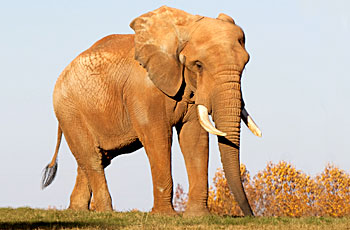
Largest of all land mammals, African elephants may reach 13 feet tall and weigh over six tons (12,000 lbs). Their two impressive tusks are modified teeth and are used to pick things up, knock things over, and dig for water. They need them a lot more than we do!
Bongo
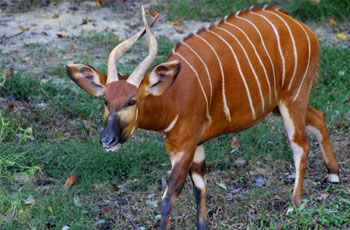
The third heaviest African antelope, behind only the giant and common eland and is the largest of the forest antelope. In the wild, they are found in lowland and mountain rainforest with dense undergrowth. However, they do depend on openings in the forest that support the growth of bushes, herbs, and other plants on which the bongo survive. Bongo are colored a rich chestnut brown, with males turning almost completely black with age. They have 12-14 vertical, white stripes from shoulders to flanks. Coat coloration, although bright out of the forest, is very concealing within the forest.
Common Waterbuck
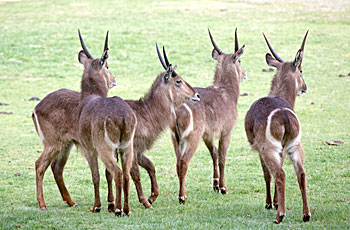
They are always found close to permanent water, usually in marsh areas and reed beds, and will flee to the water and even submerge themselves to elude predators. Waterbuck are gregarious animals, living in small herds of 5-30 animals led by large adult male. Their promary diet is grass, with some leaves, shrubs, shoots, and buds. They tend to eat grasses other grazing animals ignore which allows them to mix with zebras and wildebeest.
Greater Kudu
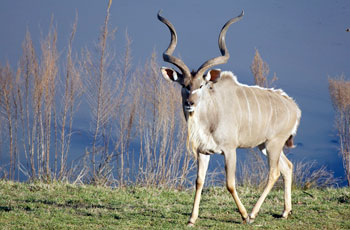
The second tallest antelope (behind only the giant eland), its color varies from a tan-grey to bluish-grey with 6-10 vertical white stripes running along the body. Males darken with age and have a chevron of white between the eyes with a crest of hair runnning along the spine. Their horns are large and spiraling. Herds are made up of 6-10 females with their offspring and males are solitary or form bachelor herds of 2-10 animals. Males only join females herds to breed. Dominance among males is established through display, standing sideways in front of another and appearing as large as possible with fights only among same-sized individuals. They live in dense bush, forest, woodlands, other bushland.
Nile Lechwe
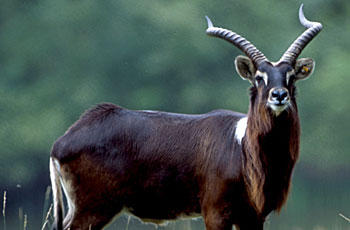
Considered “royal” animals by the Shilluk people of Sudan, they and are important in sacred traditions within the culture. The species is have very dramatic sexual dimorphism, males are a dark chocolate with a white patch on their shoulders while the females are a uniform rufous color. A highly aquatic antelope, their large hooves help them move well in water, but they are somewhat clumsy on dry land. They are adept swimmers and quite agile in shallow waters, and will travel through the water in a series of leaps when they cannot swim.
Ostrich

The ostrich can weigh over 300 pounds and stand up to nine feet tall. Although they cannot fly, they can run at speeds over 45 MPH and use their wings to help maintain balance while running. Males court females through a dance that includes bowing to the ground, shaking his feathers, swaying back and forth and waving his wings and a red blush that covers their legs and neck.
Sitatunga
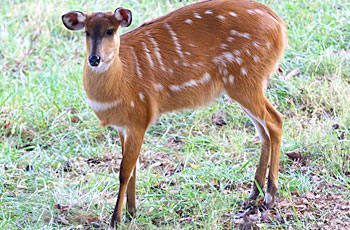
Medium-sized antelope with a long and shaggy coat, covered in a water resistant oil – an adaptation to the aquatic lifestyle. Their coat color is rufous-red in females and young males and as males mature, their coat becomes more chocolate brown with a white dorsal stripe and growing a mane. Only males possess horns. East Africa’s only amphibious antelope, they live in thickly vegetated, muddy swamps, marshes and papyrus beds. They are good, but slow, swimmers, and will rest on floating mats of vegetation. Although usually standing half-submerged in water, if threatened they will flee to deeper waters and can submerge themselves so that only their nostrils showing.
Southern White Rhino
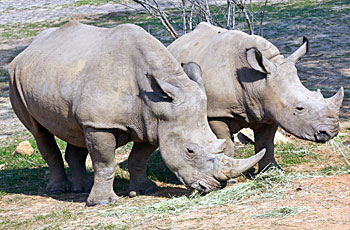
White rhinos have very poor eyesight but an excellent sense of smell. White rhino home ranges are marked by dung heaps. These communal dung heaps, or middens, are usually located at territory boundaries and serve as a message board and provides a true and honest signal of health and status. For example, a male can discover if a female is ready to mate or subordinate males can tell that there is a dominant male close by. All animals add their deposits there.
Thomson’s Gazelle
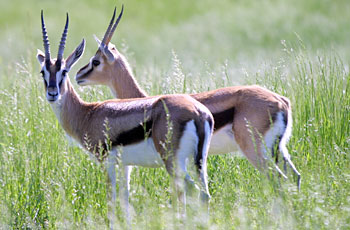
When a Thomson's gazelle is faced with danger, it can run 40 miles per hour. While running, Thomson's gazelle occasionally jumps in the air with all four feet above the ground. This technique is also known as "pronking" or "stotting".
Red River Hog
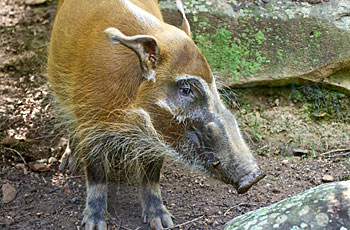
These wild pigs are widely seen through the rainforests, thickets and savannas of western and central Africa. The animals get their name from their reddish color and because they are usually found near sources of water.
Also called the “tufted pig” due to the ear tassels and long white whiskers.The are covered in bristly red coat of hair with black and white markings on head and white rings around the eyes. A crest of white hair runs the length of the spine – this will stand erect when the animal is alarmed. Snout is long and, in males, has ridges and warts running lengthwise. Upper tusks are nearly invisible, but lower are sharp and can be three inches long. They possess an incredible sense of smell and hearing. When searching for food, they will sweep their snout over the ground in circular motions. Once food is located, the firm snout is again used, this time to root up the food. The sharp tusks are used to cut through woody roots and tubers. They can hear the movements of an earthworm under the ground.
Forest Edge
The Forest Edge Habitat has giraffes, zebras and ostriches. Patrons can see the animals at four different areas. The exhibit is 3.5 acres and mimics the lightly wooded savannas found in Kenya.
Giraffe

The "Horns" are not really horns – bony lumps covered with skin and hair and called ossicones – only other animal to have them is the okapi (which is the only living relative of the giraffe).
Most giraffe have 2 ossicones, but some males may have up to 5. Easy way to tell male and female giraffes apart – males have larger “horns” and because they are used to fight, the hair on the ends is usually rubbed off. Females and young males have hair on top of their ossicones. Ossicones are flattened on newborns and pop up approximately one week after birth.
Ostrich

The ostrich can weigh over 300 pounds and stand up to nine feet tall. Although they cannot fly, they can run at speeds over 45 MPH and use their wings to help maintain balance while running. Males court females through a dance that includes bowing to the ground, shaking his feathers, swaying back and forth and waving his wings and a red blush that covers their legs and neck.
Zebra

No two zebra have the same pattern of stripes, just like the fingerprints of people. The stripes provide camouflage in the grasslands and might make it difficult to pick out individual animals in a herd. They feed on the tall, tougher grasses, leaving behind the softer shoots for other grazers.
African Lion
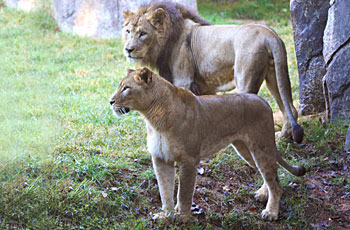
No visit to our Africa region is complete unless you see our lions. These majestic cats will leave you roaring for more.
The roar of a male lion can be heard five miles away, and their mane is not only for demonstration, but protection in fights with other males and sometimes hyenas. Although males are called King of the Beasts, in a lion pride it is the females doing the hunting for the entire group.
Kietera Forest
A large community of chimpanzees call Kitera Forest home. They’re very social and don’t mind walking up to the glass to greet visitors.
Chimpanzee
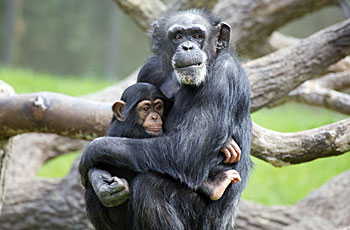
The chimpanzees at Kitera Forest are fed on Saturday and Sunday at 2 p.m.
Chimpanzees are intelligent and very social animals. They live in large troops that may number 50 individuals or more. Troops are led by a dominant, or alpha, male and female, and the hierarchy is maintained through posture, facial expressions, sounds, gestures and fights. Tool use is well documented in chimpanzees, with chimps creating tools to help them find food (using a small twig to fish out termites or smashing nuts that are too hard to crack between two rocks), obtain and transport water by chewing leaves and then soaking up water with them, and even using rocks and limbs to threaten other animals.
Lemur Island
Some of the world’s most enigmatic and full of life creatures call Lemur Island home. At this exhibit there are two species of lemurs, the ring-tailed (Lemur catta) and the red-ruffed (Varecia rubra).
Red-ruffed Lemur
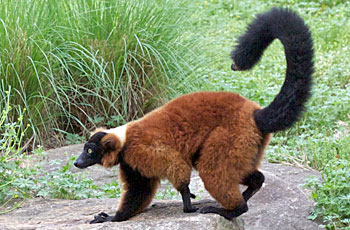
On Saturday and Sunday at 2:30 p.m., a keeper will perform a training session with the lemurs on exhibit and take questions from visitors at Lemur Island.
Found on the island of Madagascar off the east coast of Africa, the name of this primate comes from the Latin (lemures) meaning ghosts or spirit and was given to them by early explorers who were inspired by their haunting looks and calls. They spend most of their time in trees (arboreal) and live in small groups, numbering 5-6 adults. Communities can be larger, maybe reaching 30 or more. Larger groups form when food is plentiful, usually during the wet season. Like other lemurs, females are dominant within the groups. They rely on a wide variety of alarm calls to communicate danger to group members and are considered one of the most vocal non-human primates. Especially used to alert members to presence of predators, calls also used to maintain contact with other members and warn would-be competitors that might approach their territories. They depend on the sense of smell as another way to communicate with other animals. Special scent glands on the wrists and their bottoms are used to place scent marks on trees and branches to mark territory.
Ring-tailed Lemur
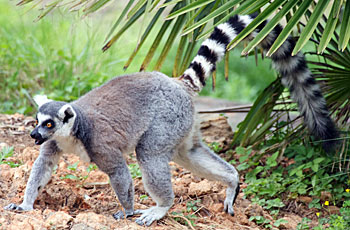
On Saturday and Sunday at 2:30 p.m., a keeper will perform a training session with the lemurs on exhibit and take questions from visitors at Lemur Island.
This primate is named for its distinctively black and white ringed tail. They are social animals, often grooming each other and eating together. In the morning they will “sunbathe” – sitting upright, exposing their bellies with front arms resting on their legs. As they travel, tails are held high, acting as flags to keep troop together. They are important in the ecosystem as seed dispersers, due to their diet of primarily fruit, and are unique among primates in Madagascar in how terrestrial they are, staying on the ground more than any other lemur. Scents is a powerful communication tool. Male R-T lemurs will engage in “stink fights”, especially during breeding season. During these duels, males will run their tails through the scent glands on their chest and wrists, getting them properly stinky. Then they will wave them at a rival to determine who is the dominant animal. Rivals will wave their tails back at the opponent or back down and run away. During the battles for dominance, each male tries to “outstink” the other.
© North Carolina Zoo